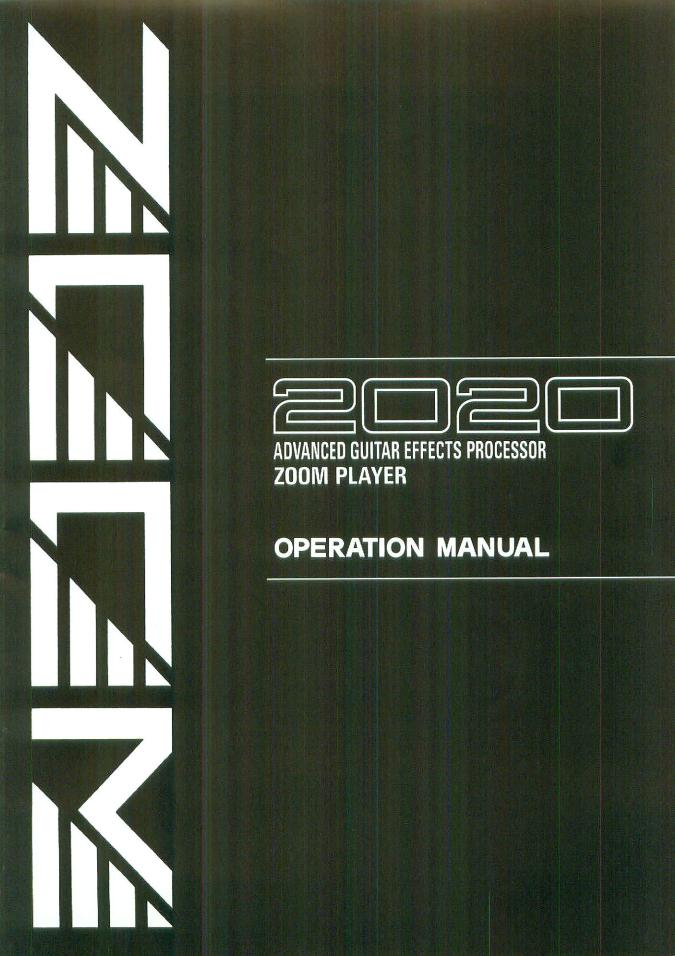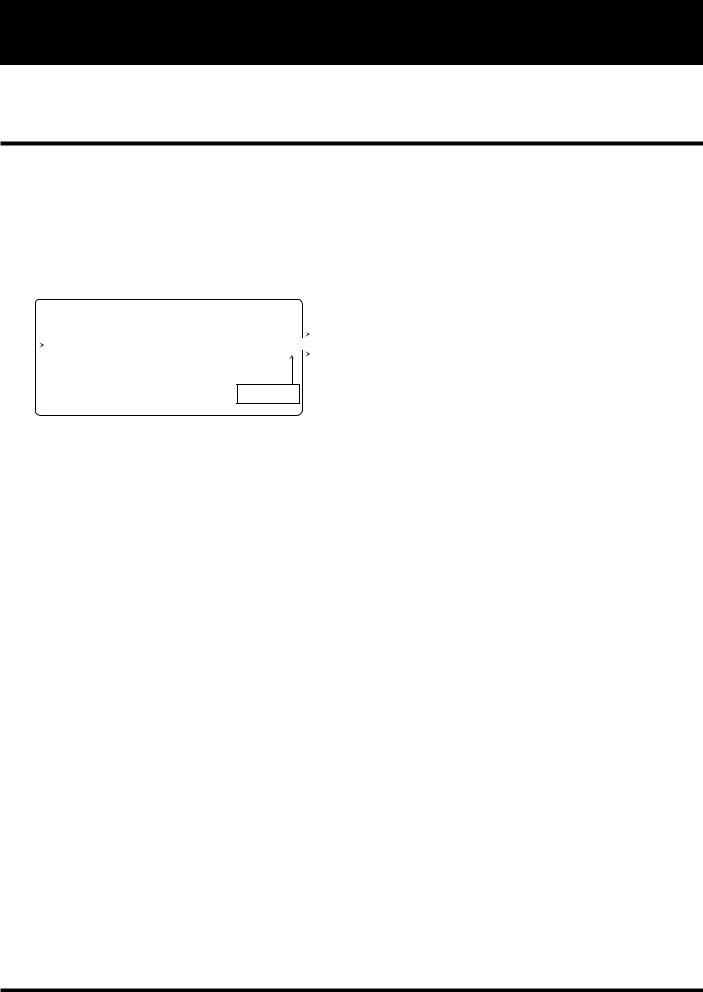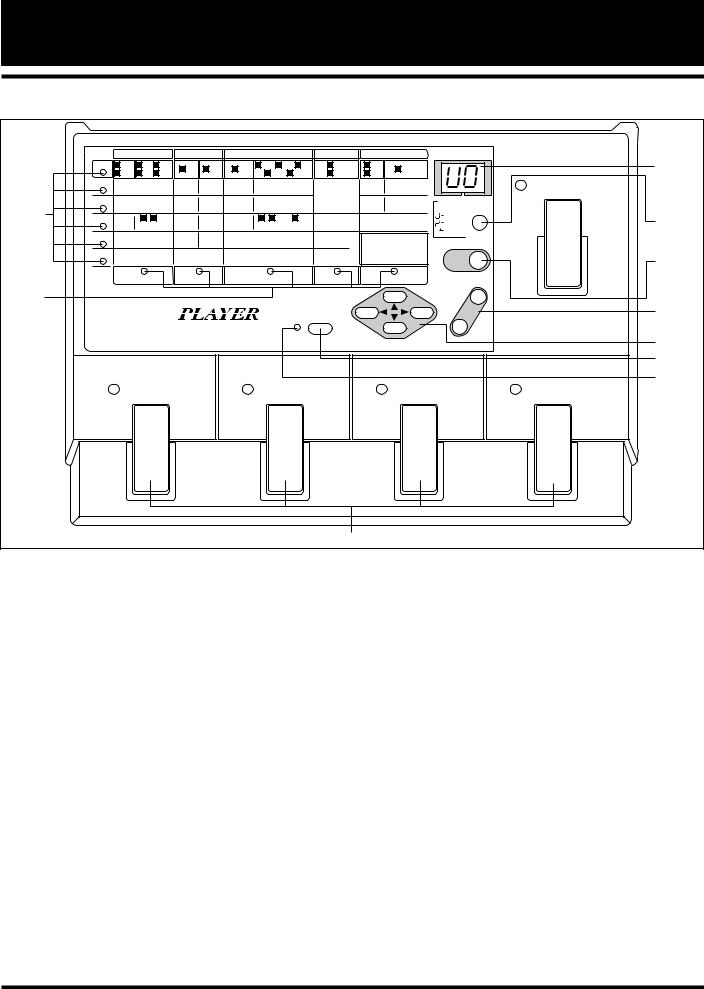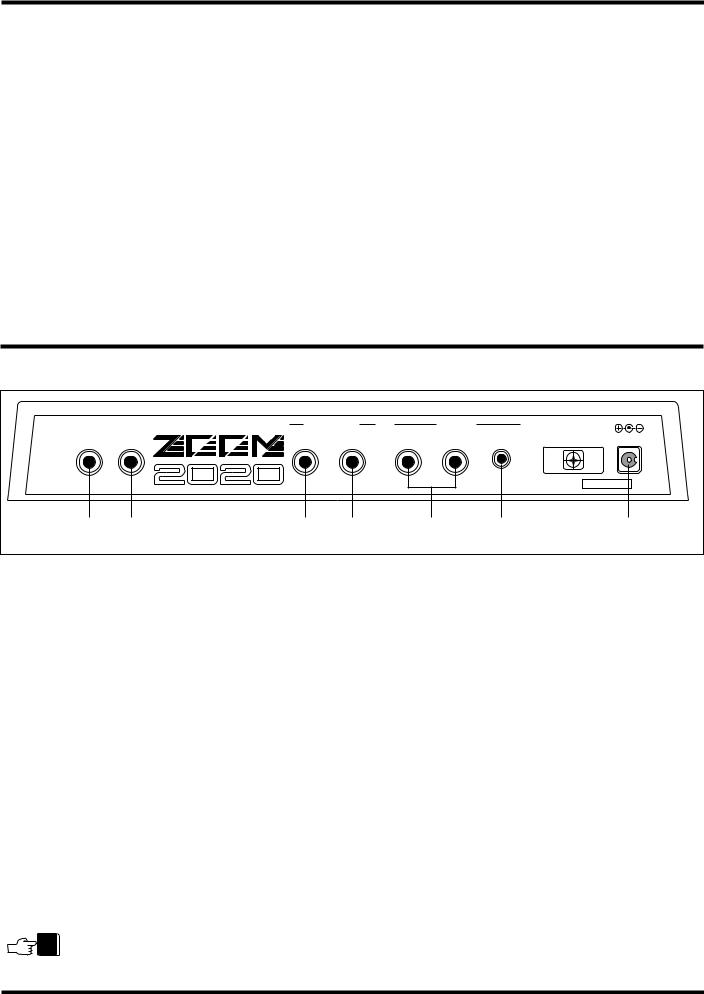Zoom 2020 Operation Manual


Thank you for selecting the advanced guitar effects processor ZOOM Player 2020 (hereafter called “2020”).
The 2020 is a sophisticated multi-effect device with the following features and functions:
•A total of 19 built-in individual effects, which can be combined in patches of up to six effects of five types. 20 preset patches and a user memory for 20 additional patches offer extraordinary flexibility.
•Integrated foot pedals and informative control panel show settings at a glance and allow easy operation like a compact effector.
•Compressor and distortion effects are generated using analog circuitry, to assure rich and natural-sounding sustain and distortion effects.
•By using the optional foot controllers FP01 or FS01, pedal wah effects and single effect on/off switching are possible, for further enhanced playability.
Please take the time to read this manual carefully, in order to get the most out of your 2020 and to ensure optimum performance and reliability.
1

Contents
Safety Precautions • • • • • • • • • • • • • • • • • • • • • • • • • • • • • • • • • • • • • • • • • • • • • • • • • • • • • • • • • • • • • • • • • • • • • • • • • • • • • • • • • • • • • • • • • • • • 3 Usage Precautions • • • • • • • • • • • • • • • • • • • • • • • • • • • • • • • • • • • • • • • • • • • • • • • • • • • • • • • • • • • • • • • • • • • • • • • • • • • • • • • • • • • • • • • • • • • • • 3
Terms Used in This Manual • • • • • • • • • • • • • • • • • • • • • • • • • • • • • • • • • • • • • • • • • • • • • • • • • • • • • • • • • • • • • • • • • • • • • • • • • • • • • • • • • 4
Names and Functions of Controls and Connectors • • • • • • • • • • • • • • • • • • • • • • • • • • • • • • • • • • • • • • • • • • • • • • • • • 5
Front Panel • • • • • • • • • • • • • • • • • • • • • • • • • • • • • • • • • • • • • • • • • • • • • • • • • • • • • • • • • • • • • • • • • • • • • • • • • • • • • • • • • • • • • • • • • • • • • • • • • • 5 Rear Panel • • • • • • • • • • • • • • • • • • • • • • • • • • • • • • • • • • • • • • • • • • • • • • • • • • • • • • • • • • • • • • • • • • • • • • • • • • • • • • • • • • • • • • • • • • • • • • • • • • • 6
Connection Examples• • • • • • • • • • • • • • • • • • • • • • • • • • • • • • • • • • • • • • • • • • • • • • • • • • • • • • • • • • • • • • • • • • • • • • • • • • • • • • • • • • • • • • • • • 7
Connection to one guitar amplifier (Example 1) • • • • • • • • • • • • • • • • • • • • • • • • • • • • • • • • • • • • • • • • • • • • • • • • • • • • • • • • • • 7 Connection to two guitar amplifiers (Example 2)• • • • • • • • • • • • • • • • • • • • • • • • • • • • • • • • • • • • • • • • • • • • • • • • • • • • • • • • • 7 Connection to a tape recorder or mixer (Example 3) • • • • • • • • • • • • • • • • • • • • • • • • • • • • • • • • • • • • • • • • • • • • • • • • • • • • • 7 Using headphones for monitoring (Example 4) • • • • • • • • • • • • • • • • • • • • • • • • • • • • • • • • • • • • • • • • • • • • • • • • • • • • • • • • • • 7
Playing a Patch (Use of the Play Mode) • • • • • • • • • • • • • • • • • • • • • • • • • • • • • • • • • • • • • • • • • • • • • • • • • • • • • • • • • • • • • • • • 8 Selecting a Patch • • • • • • • • • • • • • • • • • • • • • • • • • • • • • • • • • • • • • • • • • • • • • • • • • • • • • • • • • • • • • • • • • • • • • • • • • • • • • • • • • • • • • • • • • • • • 8 Adjusting the patch level • • • • • • • • • • • • • • • • • • • • • • • • • • • • • • • • • • • • • • • • • • • • • • • • • • • • • • • • • • • • • • • • • • • • • • • • • • • • • • • • • • • 9 Bypassing the Effects • • • • • • • • • • • • • • • • • • • • • • • • • • • • • • • • • • • • • • • • • • • • • • • • • • • • • • • • • • • • • • • • • • • • • • • • • • • • • • • • • • • • • • • 9
Editing a Patch (Use of the Edit Mode) • • • • • • • • • • • • • • • • • • • • • • • • • • • • • • • • • • • • • • • • • • • • • • • • • • • • • • • • • • • • • • • • 10 What Is a Patch? • • • • • • • • • • • • • • • • • • • • • • • • • • • • • • • • • • • • • • • • • • • • • • • • • • • • • • • • • • • • • • • • • • • • • • • • • • • • • • • • • • • • • • • • • • • 10 Entering the Edit mode • • • • • • • • • • • • • • • • • • • • • • • • • • • • • • • • • • • • • • • • • • • • • • • • • • • • • • • • • • • • • • • • • • • • • • • • • • • • • • • • • • • • 10 Panel Display in Edit Mode • • • • • • • • • • • • • • • • • • • • • • • • • • • • • • • • • • • • • • • • • • • • • • • • • • • • • • • • • • • • • • • • • • • • • • • • • • • • • • • 11 Editing a Patch • • • • • • • • • • • • • • • • • • • • • • • • • • • • • • • • • • • • • • • • • • • • • • • • • • • • • • • • • • • • • • • • • • • • • • • • • • • • • • • • • • • • • • • • • • • • • 11 Turning Effect Modules On and Off • • • • • • • • • • • • • • • • • • • • • • • • • • • • • • • • • • • • • • • • • • • • • • • • • • • • • • • • • • • • • • • • • • • • • 12 Compare • • • • • • • • • • • • • • • • • • • • • • • • • • • • • • • • • • • • • • • • • • • • • • • • • • • • • • • • • • • • • • • • • • • • • • • • • • • • • • • • • • • • • • • • • • • • • • • • • • • • 12 Storing a Patch • • • • • • • • • • • • • • • • • • • • • • • • • • • • • • • • • • • • • • • • • • • • • • • • • • • • • • • • • • • • • • • • • • • • • • • • • • • • • • • • • • • • • • • • • • • • • 12
Effect Types and Parameters • • • • • • • • • • • • • • • • • • • • • • • • • • • • • • • • • • • • • • • • • • • • • • • • • • • • • • • • • • • • • • • • • • • • • • • • • • • • • 13
Effect Module 1:Compressor + distortion (COMP+DIST) • • • • • • • • • • • • • • • • • • • • • • • • • • • • • • • • • • • • • • • • • • • • 13
Effect Module 2: Equalizer (EQ) • • • • • • • • • • • • • • • • • • • • • • • • • • • • • • • • • • • • • • • • • • • • • • • • • • • • • • • • • • • • • • • • • • • • • • • • • 14 Effect Module 3: Modulation • • • • • • • • • • • • • • • • • • • • • • • • • • • • • • • • • • • • • • • • • • • • • • • • • • • • • • • • • • • • • • • • • • • • • • • • • • • • • 15 Effect Module 4: Delay • • • • • • • • • • • • • • • • • • • • • • • • • • • • • • • • • • • • • • • • • • • • • • • • • • • • • • • • • • • • • • • • • • • • • • • • • • • • • • • • • • • • 16 Effect Module 5: Reverb • • • • • • • • • • • • • • • • • • • • • • • • • • • • • • • • • • • • • • • • • • • • • • • • • • • • • • • • • • • • • • • • • • • • • • • • • • • • • • • • • • 17 Patch Level • • • • • • • • • • • • • • • • • • • • • • • • • • • • • • • • • • • • • • • • • • • • • • • • • • • • • • • • • • • • • • • • • • • • • • • • • • • • • • • • • • • • • • • • • • • • • • • • • 17
Other Functions• • • • • • • • • • • • • • • • • • • • • • • • • • • • • • • • • • • • • • • • • • • • • • • • • • • • • • • • • • • • • • • • • • • • • • • • • • • • • • • • • • • • • • • • • • • • • • • • 18
Restoring Individual Factory Preset Patches (Patch Recall) • • • • • • • • • • • • • • • • • • • • • • • • • • • • • • • • • • • • • • • • • • • 18
Restoring All Factory Preset Patches (Initialize) • • • • • • • • • • • • • • • • • • • • • • • • • • • • • • • • • • • • • • • • • • • • • • • • • • • • • • • • 18
Application Examples for Use of Foot Pedal and Foot Switch • • • • • • • • • • • • • • • • • • • • • • • • • • • • • • • • • 19
Using the FP01 • • • • • • • • • • • • • • • • • • • • • • • • • • • • • • • • • • • • • • • • • • • • • • • • • • • • • • • • • • • • • • • • • • • • • • • • • • • • • • • • • • • • • • • • • • • • • 19 Using the FS01 • • • • • • • • • • • • • • • • • • • • • • • • • • • • • • • • • • • • • • • • • • • • • • • • • • • • • • • • • • • • • • • • • • • • • • • • • • • • • • • • • • • • • • • • • • • • 19
Specifications • • • • • • • • • • • • • • • • • • • • • • • • • • • • • • • • • • • • • • • • • • • • • • • • • • • • • • • • • • • • • • • • • • • • • • • • • • • • • • • • • • • • • • • • • • • • • • • • • 20
2

Safety Precautions
Please observe the following safety tips and precautions to ensure hazard-free use of the 2020.
• Power requirements
The 2020 is powered by the supplied AC adapter AD0003/AD0004. Do not use any other kind of AC adapter to prevent malfunction and safety hazards.
When wishing to use the 2020 in an area with a different line voltage, please consult your local ZOOM distributor about acquiring a proper AC adapter.
• Environment
Avoid using your 2020 in environments where it will be exposed to:
•Temperature extremes
•High humidity or moisture
•Excessive dust or sand
•Excessive vibration or shock
•Handling
Since the 2020 is a precision electronic device, avoid applying excessive force to the switches and buttons. Also take care not to drop the unit, and do not subject it to shock or excessive pressure.
• Alterations
Never open the case of the 2020 or attempt to modify the product in any way since this can result in damage.
• Connecting cables and input and output jacks
You should always turn off the power to the 2020 and all other equipment before connecting or disconnecting any cables. Also make sure to disconnect all cables and the AC adapter before moving the 2020.
Usage Precautions
• Electrical interference
The 2020 uses digital circuitry that may cause interference and noise if placed too close to other electrical equipment, such as TV sets and radio receivers. If such problems occur, move the 2020 further away from the affected equipment. Also, when fluorescent lights or devices with built-in motors are close to the 2020, the unit may not function properly.
• Cleaning
Use a soft, dry cloth to clean the 2020. If necessary, slightly moisten the cloth. Do not use abrasive cleanser, wax, or solvents (such as paint thinner or cleaning alcohol), since these may dull the finish or damage the surface.
Please keep this manual in a convenient place for future reference.
3

Terms Used in This Manual
This manual has been written so that it can be easily understood also by first-time users. However, the 2020 offers several special functions which are not available with a conventional compact effector. This section explains some of the terms used throughout the manual to describe such functions.
• Effect Module
The 2020 offers five basic effect groups, as shown in the illustration below. Such an effect group is referred to as an “effect module”. Each effect module can be thought of as a single compact effector. The 2020 therefore operates like five compact effectors connected in series. The following effect modules are available:
PATCH
|
|
|
|
|
|
|
|
|
|
|
|
|
INPUT |
|
COMP+ DIST |
|
EQ |
|
MODULATION |
|
DELAY |
|
REVERB |
OUTPUT |
|
|
|
|
|
|
||||||||
|
|
|
|
|
|
|
|
|
|
|
|
|
|
|
|
|
|
|
|
|
|
|
|
|
|
PATCH LEVEL
•COMP+ DIST (Analog compressor and distortion effects)
•EQ (Equalizer and wah effects)
•MODULATION (modulation effects such as chorus and flanger)
•DELAY (delay effects)
•REVERB (reverberation effects)
•Effect Type
Each effect module contains several effect variations which are called “effect types”. Each effect module can use one effect type at a time. For a list of effect types in each effect module, see the table on page 13.
• Patches and Groups
The 2020 allows you to use a maximum of five effect modules simultaneously. A combination of effect modules, each with individual parameter settings plus the final output level setting, is referred to as a “patch”.
The 2020 has two memory areas or “groups” where patches are stored: the user group for patches created by the user, and the preset group for factory defined patches where only the output level can be changed.
• Bank
The 2020 calls up patches in sets of four, and the foot pedals serve to switch between patches. Such a set of four patches is referred to as a “bank”. To select a patch, first specify the group and the bank, and then use the foot pedals to select patch number 1 - 4.
GROUP |
BANK No. |
PATCH No. |
|
|
|
|
0 |
1 – 4 |
|
|
|
|
1 |
1 – 4 |
USER |
|
|
2 |
1 – 4 |
|
|
|
|
|
3 |
1 – 4 |
|
|
|
|
4 |
1 – 4 |
|
|
|
|
0 |
1 – 4 |
|
|
|
|
1 |
1 – 4 |
PRESET |
|
|
2 |
1 – 4 |
|
|
|
|
|
3 |
1 – 4 |
|
|
|
|
4 |
1 – 4 |
|
|
|
• Parameter
The elements which determine the sound of an effect are referred to as “parameters”. Parameter values can be adjusted for each effect module, to create your own patches with the 2020.
• Mode
The functions of the 2020 can be roughly divided into three different categories. These are called “modes”, as described below.
•Play Mode
In this mode, patches can be selected and played. This is the default mode of the 2020 when power is turned on.
•Edit (Manual) Mode
In this mode, the parameters of each patch can be edited. The mode can also be used as a manual mode to switch effect modules on and off during a performance using a foot pedal.
•Special Mode
Serves to return some or all patch data to the factory preset condition.
4

Names and Functions of Controls and Connectors
Front Panel
|
|
COMP+ DIST |
|
EQ |
|
MODULATION |
|
DELAY |
|
REVERB |
(EDIT VALUE) |
(1) |
|||
|
EFFECT |
1 CLN I |
3 OD I |
5 DST I |
1 EQ |
2 WAH |
1 PIT |
2 PHA 3 FLG |
4 TRM |
1 MONO |
1 REV |
|
|
||
|
|
2 CLN II |
4 OD II |
6 DST II |
5 STEP 6 CHO |
2 PPD |
2 E/R |
3 DELAY |
|
|
|||||
|
|
|
|
|
|
|
|
BANK |
|||||||
|
PARM1 |
COMP |
|
HIGH |
SENS |
PIT |
DEPTH |
|
[0-10](x100mS) |
TIME |
TIME |
|
|
||
|
|
[0-3] |
|
[–7-+7] |
[0-10] |
[–12-+12] |
[0-10] |
|
[1-10] |
[0-90](x100mS) |
|
|
|||
|
|
|
|
DELAY TIME |
|
|
|||||||||
|
PARM2 |
EDGE |
|
MID |
FREQ |
FINE |
RATE |
|
TONE |
FEEDBACK |
|
|
|
||
|
|
|
[0-99](mS) |
GROUP • BANK |
|
||||||||||
(9) |
|
[0,1] |
|
[–7-+7] [1-64] |
[–10-+10] |
[1-50] |
|
[–7-+7] |
[0-10] |
|
|||||
|
|
|
|
|
|
|
|||||||||
PARM3 |
|
3 – 6 GAIN |
MIDf |
|
BAL |
2 – 5 PERK |
6 STR |
FEEDBACK |
|
MIX |
|
USER |
(2) |
||
|
|
|
[1-8] |
[1-16] |
|
[0-10] |
[0-10] |
[0,1] |
[0-10] |
[0-10] |
( ) |
PRESET |
|||
|
PARM4 |
ZNR |
|
LOW |
|
|
|
|
MIX |
|
|
|
BOTH |
(10) |
|
|
|
|
|
|
|
|
|
|
GROUP |
||||||
|
|
[0-15] |
|
[–7-+7] |
|
|
|
|
[0-10] |
|
PATCH LEVEL |
|
|||
|
|
|
|
|
|
|
|
|
|
|
|||||
|
PARM5 |
|
|
|
LEVEL |
|
|
|
|
|
[0-31] |
|
STORE |
(3) |
|
|
|
|
|
|
|
[1-8] |
|
|
|
|
|
|
|
||
|
|
1 COMP+DIST |
2 |
EQ |
3 |
MODULATION |
|
4 DELAY |
B |
REVERB |
|
|
|
||
(8) |
|
|
|
|
|
|
|
|
|
|
|
|
|
VALUE |
|
|
|
|
|
|
|
|
|
|
|
|
|
|
+ |
(4) |
|
|
|
ZOOM |
|
|
|
EDIT (MANUAL) |
|
|
|
||||||
|
|
|
|
|
|
|
|
– |
|||||||
|
|
ADVANCED GUITAR EFFECTS PROCESSOR |
|
|
|
|
|
|
|
||||||
|
|
|
|
|
|
|
|
CANCEL |
|
PARAMETER SELECT |
|
|
(5) |
||
|
|
|
|
|
|
|
|
|
|
|
|
|
|
|
(6) |
|
|
|
1 |
|
|
|
2 |
|
|
|
3 |
|
|
(7) |
|
|
|
|
|
|
|
|
|
|
|
|
4 |
||||
|
|
|
|
|
|
|
|
|
|
(11) |
|
|
|
|
|
(1) Display |
|
|
|
|
|
|
|
|
|
|
(4) VALUE + / - keys |
|
|||
The display shows vital information for operating the 2020, such as group and bank numbers of a patch, effect parameter values and other messages.
(2) GROUP key
•In Play mode
Serves to select the memory group for the patch, as follows.
USER Only patches from the user group are available.
PRESET Only patches from the preset group are available.
BOTH Patches from both groups are available.
•In Edit mode
Serves to compare the currently edited patch with the patch before editing (compare function). For details, please refer to page 12.
(3) STORE key
Serves to store an edited patch with its new parameter and level settings in the user group.
These keys serve to change the value of a parameter. Tapping the VALUE + key increases the value by one step, and tapping the VALUE - key decreases the value by one step. Keeping a key depressed changes the value continuously. To increase the speed of the change, press the other key as well.
•In Play mode
The keys serve to adjust the output level of the patch.
•In Edit mode
The keys serve to select an effect type and adjust the currently selected parameter.
(5) PARAMETER SELECT keys
Serve to select the parameter to be edited in Edit mode.
(6) EDIT (MANUAL) / CANCEL key
Pressing this key switches from Play mode to Edit mode. The Edit mode can also be used as Manual mode to switch effect modules on and off with a foot pedal.
The key also serves to return from the Edit mode to the Play mode, and to cancel a store process.
5

(7) Edit mode LED
This LED lights up when the 2020 is in the Edit (Manual) mode.
(8)Module cursor LED
• In Play mode
Lit LED indicates which effect module in the current patch is ON.
• In Edit mode
Lit LED indicates which effect module in the currently edited patch is ON, and flashing LED indicates the currently edited effect module.
(9)Parameter cursor LED
Flashing LED indicates the currently edited parameter in Edit mode.
(10)BANK pedal
• In Play mode
Selects the next higher bank.
• In Edit (Manual) mode
Switches REVERB for the effect module on and off. The pedal LED lights up when REVERB is on.
(11)Pedal 1 - 4
•In Play mode
The pedals serve to select a patch. The respective pedal LED lights up.
•In Edit (Manual) mode
The pedals serve to switch the effect modules COMP+DIST, EQ, MODULATION, DELAY on and off. The respective pedal LED lights up.
Rear Panel
INPUT |
TUNER |
CONTROL IN |
|
OUTPUT |
|
|
|
|
MANUAL(SW) |
|
|
PHONES |
DC9V 150mA |
||
|
OUT |
VOLUME |
/WAH(PEDAL) |
L/MONO |
R |
(REC OUT) |
|
|
|
|
|
|
|
|
SERIAL No. |
(1) |
(2) |
(3) |
(4) |
(5) |
|
(6) |
(7) |
(1) INPUT jack
Serves for connection of a guitar.
(2) TUNER OUT jack
The guitar signal from the input is supplied without alteration at this output, to allow tuning without the need for cabling changes.
(3) CONTROL IN VOLUME jack
This connector allows use of the optional foot pedal FP01 to control the volume level of the 2020. Since the level is adjusted between the EQ module and the MODULATION module, the volume can be changed without affecting reverberation.
(4) CONTROL IN MANUAL/WAH jack
This jack serves for connection of the optional foot switch FS01 or foot pedal FP01. The FS01 can be used to switch between Play mode and Manual mode, and the FP01 can be used to control the wah effect of the EQ effect module.
NOTE When connecting the FP01 to a CONTROL IN jack, use the EXP. OUT connector of the FP01.
(5) OUTPUT L/MONO/R connectors
Serves for connection to a guitar amplifier. To use the 2020 in stereo, connect cables to both jacks. For a monaural setup, connect the cable to the L/MONO jack.
(6) PHONES (REC OUT) jack
For connection of a pair of stereo headphones. Since the output at this jack has been processed by an amp simulator, it can also be used as recording output for connection to a tape recorder or mixer.
(7) DC INPUT (AC adapter) jack
The supplied AC adapter is connected here. To guard against inadvertently disconnecting the adapter cable, wind the cable once around the hook. As long as the AC adapter is connected here, the unit is turned on. There is no separate power switch.
6
